**3rd-Great maternal Grandparents of Eula Claudine Reed
George Brownlee**:
Parents: James Brownlee & Jean Webb
Born: About 1756 (Antrium, Ireland)
Died: February 17, 1836 (Abbeville County, South Carolina)
Buried: Greenville Presbyterian Church Cemetery (South Carolina)
Sarah Caldwell** (spouse):
Parents: Unknown & Unknown
Born: About January 1758 (Abbeville, South Carolina)
Married: About 1787 (Abbeville, South Carolina)
Died: April 13, 1826 (South Carolina)
Buried: Greenville Presbyterian Church Cemetery (South Carolina)
Children:
- John A. Brownlee (Born: about 1779);
- George Harvey Brownlee (Born: 1782);
- Jane Brownlee (Born: 4/29/1787 ?);
- Elizabeth Brownlee (Born: 9/6/1787);
- Eleanor Brownlee (Born: about 1791);
- Sarah Brownlee** (Born: 1/12/1795);
- Isabelle Brownlee (Born: 2/19/1798);
- Martha Brownlee (Born: 3/9/1802).
*George Brownlee Sr. and Sarah Caldwell are shared ancestors of President Jimmy Carter through their daughter Eleanor.[1]
Genealogical Sketch:
Born in Atrium (Ireland), at the age of eleven George Brownlee departed the port in Belfast (Ireland) aboard “The Lord Dungannon“on or before October 12, 1767. George Brownlee sailed with his 32 year-old father James Brownlee, and his 8 year-old brother John Brownlee. It is believed his mother Jean Brownlee died before voyage, but it is possible she died while at sea. Among the other passengers were his 40 year-old Uncle John Brownlee, his 36 year-old Aunt Alice Brownlee, his 19 year-old cousin Joseph Brownlee, his 18 year-old cousin Jane Brownlee, and his 15 year-old cousins Alice/Ann Brownlee. “The Lord Dungannon” arrived in Charleston (South Carolina) with 154 passengers on February 1, 1768.[2]
- The British encouraged settlement by “poor protestants” in the South Carolina frontier (upcountry) to provide a buffer between the Native Americans and the wealthy plantations in the South Carolina low-country.
George Brownlee Sr. settled with his father and establish a farm “on a branch of the West Fork of Long Cane known by the name of Clarks Creek”. The rural community of Long Cane Creek (located between Long Cane Creek and Little River) had been established in the 1750’s by Scots-Irish settlers on the fertile land originally claimed by the Cherokee. There was a small fortification known as “Fort Boone” on a tributary of Long Cane Creek and the nearest town was Ninety-Six.
- On February 1, 1760, Cherokee warriors attacked the settlers as they attempted to move from Long Cane Creek to the safety of Fort Moore (near Augusta Georgia). During the attack (known as “the Long Cane Massacre”), 23 settlers were killed (including Catherine Calhoun, the mother of Patrick Calhoun), 14 settlers were taken hostage, and nine children were scalped (all survived). Fort Boone was built in the fall of 1760 when the settlers returned under the protection of the Chickasaw Indians.
Although her gravestone indicates she was born in 1757 or 1759, little more is known about who her parents were or how Sarah Caldwell found her way to the backcountry of South Carolina. An initial analysis of the Autosomal DNA of her descendants (see Discovering the Parents of Sarah Caldwell) indicates she was related to John Caldwell (1682-1750) and his wife Mary Margarette Phillips (1685-1748). Another DNA link indicates Sarah Caldwell may have been the daughter of John Caldwell (1715-1775) and his wife Jane Kennedy (1720-1780). In addition, there were DNA links to Curtis Caldwell (1737-1784), Mary Caldwell (1745-1815), Rachel Caldwell (1749-1797), and Margaret Jane Caldwell (1758-1820). Hopefully, as we continue to sift through these DNA links the identity of her parents (along with her story) will be reveal.
During the American Revolution, George Brownlee Sr. served 139 days in the South Carolina Militia (as a private fighting against the British).[3] The Long Cane Creek settlers and nearby town of Ninety-Six would be a focal point of conflict from the outset of the Revolutionary War. Most of the armed conflicts in this region were between colonial militias (Loyalist vs Patriots). Without a strong established governmental structure, “frontier justice” prevailed resulting in full scale civil war forcing many settlers to change their allegiance to avoid reprisals.
The 18 year-old George Brownlee Sr. may have been involved in the First Siege of Ninety-Six (aka: Siege of Savage’s Old Fields) from November 19-21, 1775. Major Andrew Williamson of White Hall (Abbeville County) organized 562 patriot militiamen and fortified a farm field outside Ninety-Six as they were surrounded by 1,892 loyalist militia command by Patrick Cunningham and Joseph Robinson. With neither side willing to fulling engage the other, the three day siege ended with an uneasy agreement that both sides would withdraw after only minor casualties (Loyalist: 4 killed/20 wounded; Patriots: 1 killed/12 wounded).
George Brownlee’s granddaughter (Sarah Jane Lyon) recalled stories about him “soldiered against the Indians“. Sarah Brownlee would later recount to her granddaughter of the terror when one night she heard “some cattle trampling the brush near their dwelling and they imagined that they were Indians prowling around with murderous intent“.[4] On July 1, 1776, Cherokee warriors had attacked the farm of Captain Aaron Smith on Little River in the Ninety-Six District of South Carolina killing Smith, his wife, five of his children and five slaves.
In response, Major Andrew Williamson assembled 330 local patriot militia (likely including George Brownlee) mounted with rifles at “Due West” in Abbeville County. Major Williamson departed and was ambushed by Cherokee warriors and loyalist on August 1st in the Battle of Twelve Mile Creek followed by several other skirmishes. Major Williamson’s force rapidly grew with reinforcements and defeated the Cherokee in what would be known as the “Cherokee Campaign“. On May 20, 1777, the Treaty of Dewitt’s Corner was signed near the home of George Brownlee Sr. with the Cherokee ceding nearly all their remaining lands in South Carolina.
Greoge Brownlee Sr. may have served under Captain William Harris in the Battle of Long Canes on December 20, 1780. Captain Harris led a “Little River” militia company and was the son of Reverend John Harris, the pastor of the Presbyterian church George Brownlee Sr. was a member. Reverend John Harris was an ardent patriot, boasted of his congregation’s loyalty, and said to have preached with a gun in the pulpit.
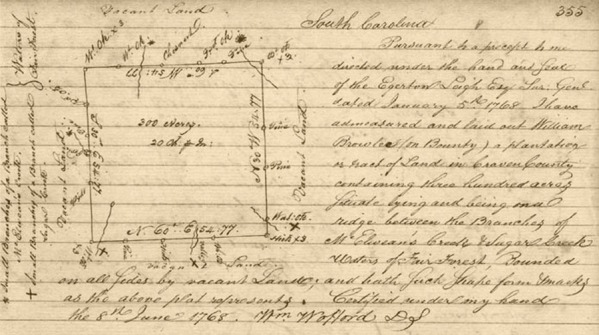
On or about August 1, 1782, George Brownlee (Sr) provided “three Beeves for the use of General Pickens Brigade the on Duty” (see below). The receipt for the butchered cattle (beeves) was prepared by Captain John Norwood, the commander of a company of mounted “Little River” militia “Rangers” based nearby at the home of John Miller (see Miller’s Station).[5] Encamped at Long Cane, General Pickens Brigade was preparing for the second campaign against the Cherokee in August 1782.
- From September 16 to October 1782, General Andrew Pickens lead his brigade against the Cherokee and British loyalist led by Colonel Thomas Waters in and around Long Swamp Creek (present-day Cherokee County, Georgia) killing “all who had the appearance of warriors”.[6]

On August 7, 1784, a Plat was recorded for George Brownlee for 100 acres on “Chickisaw Creek” in the Ninety-Six District of South Carolina.[7] On April 27, 1785, a Plate was recorded for George Brownlee for 224 acres on “Branch of Parks Creek” in the Ninety-Six District of South Carolina.[8] On May 22, 1785, a Plat was recorded for George Brownlee for 200 acres on “Branch of Checkasaw Creek” in the Ninety-Six District of South Carolina.[9] On November 23, 1790, a Plat was recorded for George Brownlee for 140 acres on “Branches of Checesaw and Little Hogskin Creeks” in Ninety-Six District of South Carolina.[10]
- In 1785, Abbeville County was created from Ninety-Six District of South Carolina. In 1798, Abbeville County was designate as Abbeville District and was changed back to Abbeville County in 1868.
According to the first Federal Census (1790), George Brownlee (16 and over) was living in Abbeville County, South Carolina. George Brownlee was living with two free white males (under 16) and four free white females. George Brownlee owned one slave.
- Living in the next household was the father of George Brownlee, James Brownlee (16 and over). James Brownlee was living with one free white male (under 16) and owned three slaves.
In 1797, the Grenville Presbyterian Church (formerly Saluda) in Abbeville had split from the Long Cane Church. Without a permanent pastor, the congregation fell to about forty members with only two elders. Despite the religious fervor of the Second Great Awakening that was sweeping across the region, “a degree of coldness prevailed among the people” attending church. Yet, with a new pastor they built a new church building and, George Brownlee (Sr), John Weatherall, and Edward Sharp were elected as ruling elders and ordained (about 1802).[11]
On November 7, 1798, a Plat for George Brownlee for 206 acres on “Branch of Long Cane Creek” in Abbeville County, South Carolina.[12] Part of the rising southern gentry (upper class) built on the cheep slave labor, George Brownlee purchased slaves from Africa to keep pace with his increasing land holdings. In 1807, there was a notice in the local newspaper (Miller’s Weekly Messenger) George Brownlee offered a reward for five runaway slaves. The notice read “Five Negroes; three of them Africans…Speak tolerable good English,” and two “country-born“.[13]
According to the 1810 Federal Census, George Brownlee (45 and over) was living in Abbeville Township in Abbeville County, South Carolina. George Brownlee (Sr) was living with his wife (45 and over), two free white white females (16-25), two free white females (10-15), and a free white female (under 10). George Brownlee (Sr) owned ten slaves.
- Living nearby was the son of George Brownlee (Sr), George Brownlee Jr. (26-44). George Brownlee Jr. was living with his wife (16-25) and owned five slaves;
- Living close by was the son of George Brownlee (Sr), John Brownlee (26-44). John Brownlee was living with his wife (26-44), two daughters (under 10), and son (under 10). John Brownlee owned four slaves;
- Living close by was the nephew of George Brownlee (Sr), James Brownlee (26-44). James Brownlee was living with his wife (26-44), son (10-15), daughter (10-15), and four sons (under 10).
According to the 1830 Federal Census, George Brownlee (70-79) was living in Abbeville County, South Carolina. George Brownlee (Sr) was living with a free white male (20-29), a free white female (15-19), two free white males (under 5), and two free white females (under 5). George Brownlee (Sr) owned 24 slaves.
- Living nearby was the son of George Brownlee (Sr), George Brownlee (40-49). George Brownlee (Jr) was living with his wife (30-39), two sons (15-19), son (10-14), two daughters (5-9), two sons (5-9), and two daughters (under 5). George Brownlee (Jr) owned 13 slaves.
On March 13, 1834, a Plat was recorded for George Brownlee Sr. for 830 acres on Chickasaw Creek in Abbeville District, South Carolina.[14]
On December 30, 1833, George Brownlee Sr. prepared his last will for his extensive estate. The will was present to the probate court in Abbeville District (South Carolina) by Moses Taggart, Esquire; and was witnessed by Samuel Donald, William Hill, and James Webb.[15] The will was proven by the Oath of J.L. Webb and qualified by the his grandson George Brownlee, his son-in-law Francis B. Clinkscales and his son George H. Brownlee, on February 22, 1836; and qualified by (son-in-law?) H. Morrah and (son-in-law?) A. Lomax on February 25, 1836.
“I, George Brownlee of Abbeville District, considering the uncertainty of this mortal life and being of sound and perfect mind and memory (blessed be Almighty God for the same) do make this my Last Will and Testament in manner and form following.
Item: I will and bequeath unto my Grandchild, Sally Rasor, daughter of my son, John Brownlee, the sum of two hundred dollars to her and her heirs forever.
Item: I will and bequeath unto my Granddaughter, Elizabeth Brownlee, daughter of my son, John Brownlee, the sum of two thousand five hundred dollars $2,500 to her and her heirs forever.
Item: I will and bequeath unto my daughter-in-law, Maria Brownlee, widow of my son, John Brownlee, the sum of fifty dollars $50 to her heirs forever.
Item: I will and bequeath unto the other remaining children of my son, John Brownlee (after the above mentioned Sally and Elizabeth) that may be alive at the time of my decease, the sum of two thousand dollars $2,000 share and share alike, to them and their heirs forever – and after the aforementioned legacies are paid out, I direct that whatever may be remaining of my property shall be distributed and divided in the manner and form following.
Item: I will and bequeath unto my son, George Brownlee, one seventh part of my estate to him and his heirs forever.
Item: I will and bequeath unto my daughter, Elizabeth Lomax one seventh part of my estate to her and her heirs forever.
Item: I will and bequeath unto my daughter, Jane Morah one seventh part of my estate to her and to her heirs forever.
Item: I will and bequeath unto my daughter Elsey Clinkscales children one seventh part of my estate to be shared by each of their heirs forever.
Item: I will and bequeath unto my daughter Sarah Miller one fourteenth part of my estate to her and her heirs forever.
Item: I will and bequeath unto my daughter Sarah Miller one fourteenth part of my estate to be shared alike for each child and their heirs forever.
Item: I will and bequeath unto my daughter Martha Richey one seventh part of my estate to her and her heirs forever.
Item: I will and bequeath unto my daughter Isabelle Kay one seventh part of my estate to her and her heirs forever.
Item: I will and bequeath all my books to be equally divided among all my surviving children
Item: I nominate and appoint George Brownlee, Harvey Brownlee, Francis B. Clinkscales, Hugh Morrah and Aaron Lomax to be Executors of this my Last Will and Testament and I do, hereby, utterly revoke and disallow all and every former Wills and Testaments and legacies or executors by me in any wise before named, willed or bequeathed, ratifying and confirming this to be my Last Will and Testament. In witness whereof, I have set my hand and seal this thirteenth day of December in the year of our Lord one thousand eight hundred and thirty-three.”
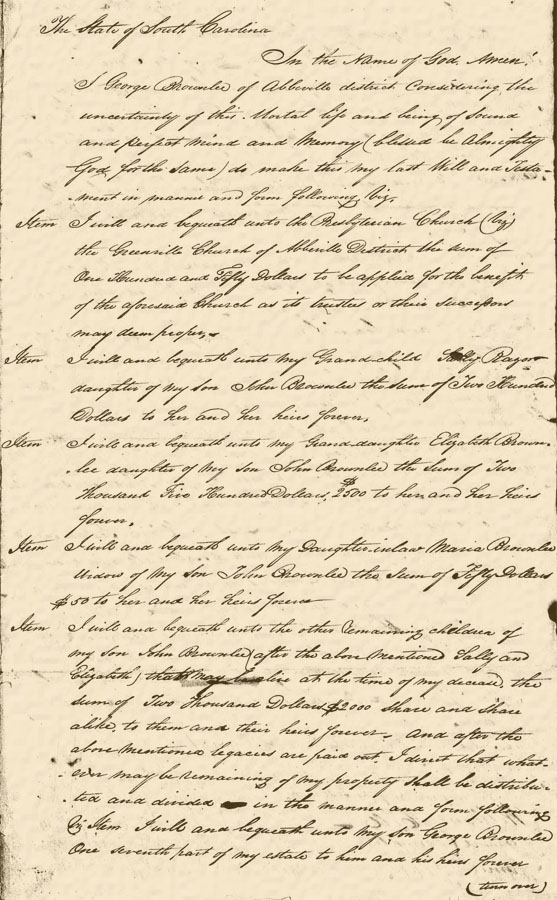
Copy of original will for George Brownlee, Sr. (page 1).
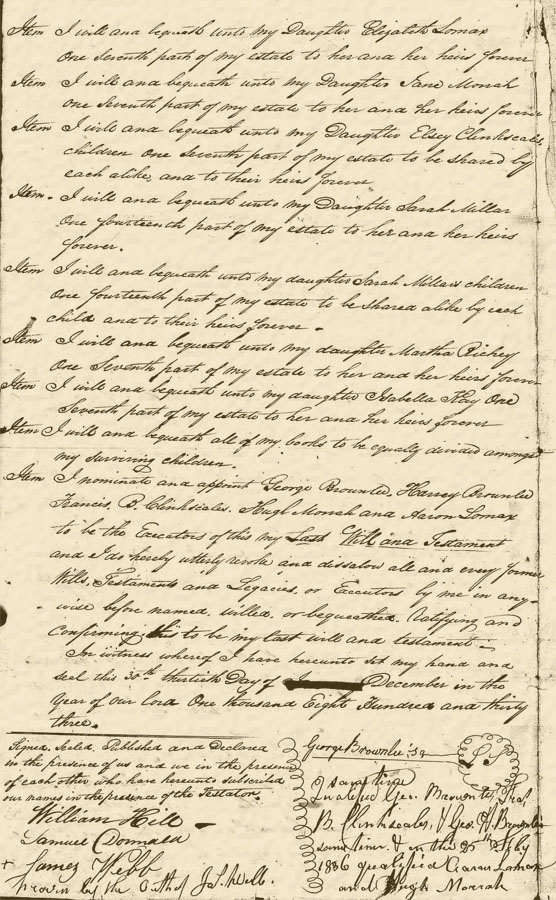
Copy of original will for George Brownlee, Sr. (page 2).
In 1836, a case was filed in the Abbeville County Equity Court (Geo A. Brownlee v. Hugh Morrah & wife Morrah) which apparently involved to a dispute linked to the will of George Brownlee Sr. and his son-in-law Hugh Morrah. The notes of another researcher suggests Robert Kay was married to Isabella Brownlee (Box 70-Pkg 3566). In 1844, the estate for the deceased George Brownlee Sr sold for an reported $8,816.73. The estate had included “fifty-six shares in the Bank of South Carolina, 175 shares in the Planters and Mechanics Bank, and one thousand dollars in city of Charleston bonds“.[16]
- A unrelated 1838 case (Aron Lomax et al v. Jane Morrah et al) indicates Hugh Morrah had inherited a substantial amount of wealth from the estate of his father-in-law George Brownlee in right of his wife Jane (Box 66-Pkg 3406).
Gravestones:
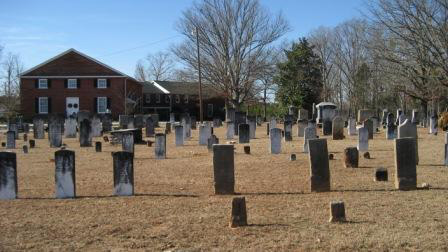
Greenville Presbyterian Church Cemetery. This historic church dates back to 1773 and the cemetery dates back to 1777.
George Brownlee Sr. and his wife Sarah Brownlee are both buried in the historic Greenville Presbyterian Church Cemetery in Abbeville County, South Carolina. In 1952, an application to replace “an old delapitated stone marker” for George Brownlee Sr. was approved and a new flat marker was placed marking his grave.[17]
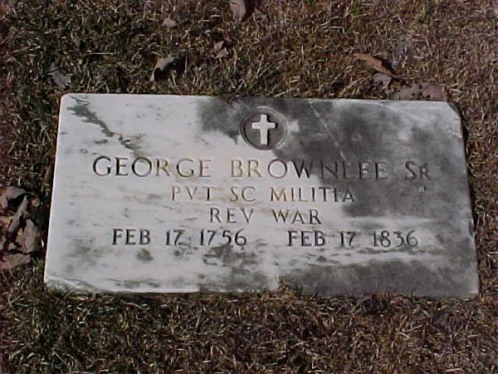
Photo of the headstone for George Brownlee Sr. provided by Patricia (findagrave.com).
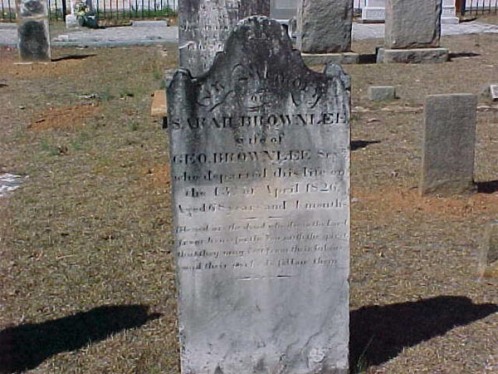
Photo of the headstone for Sarah Brownlee provided by Patricia (findagrave.com).
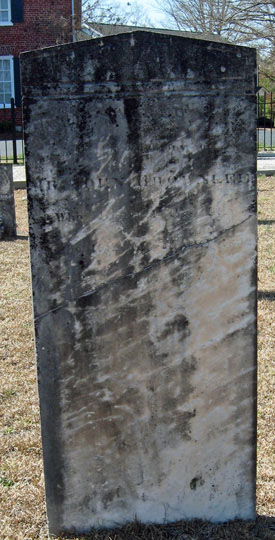
Photo of the headstone for the son of George Brownlee Sr, John Brownlee (findagrave.com).
[1]Ancestors of Jimmy and Rosalynn Carter by Jeff Carter, Page 79.
[2]South Carolina Immigrants (1760 to 1770) by Jack Moreland Jones and Mary Bondurant Warren (need page number).
[3]Roster of South Carolina Patriots in the American Revolution. Volume I, A-J by Bobby Gilmer Moss, Page 113; Stub Entries to Indents Issued in Payment of Claims Against South Carolina Growing Out of the Revolution, (Books B-I & K-Z) edited by A.S. Sally Jr, Page 104 (Indent No. 643).
[4]A Place Called Due West by Lowry Ware, Pages 19-28.
[5]George Brownlee Account Audited (File No. 834) Of Claims Growing Out Of The American Revolution (South Carolina Archives, Series S108092, Reel 15, Frame 220); Stub Entries to Indents Issued in Payment of Claims Against South Carolina Growing Out of the Revolution, (Books B-I & K-Z) edited by A.S. Sally Jr, Page 104 (Indent No. 643).
[6]The Life and Times of General Andrew Pickens by Rod Andrew Jr., Pages 157-161.
[7]South Carolina Department of Archives, Series S213190, Vol. 3, Page 19, Item 2.
[8]South Carolina Department of Archives, Series S213190, Vol. 10, Page 22.
[9]South Carolina Department of Archives, Series S213190, Vol. 7, Page 75, Item 2.
[10]South Carolina Department of Archives, Series S213190, Vol. 26, Page 178.
[11]History of the Presbyterian Church in South Carolina (1802-1883) by George Howe, Page 140.
[12] South Carolina Department of Archives, Series S213192, Vol. 37, Page 155, Item 1.
[13]African American Life in South Carolina’s Upper Piedmont, 1780-1900 by W. J. Megginson, Page 78.
[14]South Carolina Department of Archives, Series S213192, Vol. 47, Page 230, Item 2.
[15]Abbeville County (South Carolina) Probate Records, Boxes 5-6, Packages 81-112.
[16] “Silver Spoons and Spyglasses: The Lifestyle of Abbeville Gentry, 1820-1860” by Larry S. Bell & Marvin L. Cain, The South Carolina Historical Magazine, October 2014, Volume 115, No. 4; Page 312.
[17]U.S. Headstone Application for Military Veterans for George Brownlee Sr. (OQMG Form 623, Rev. 15, Apr 47).